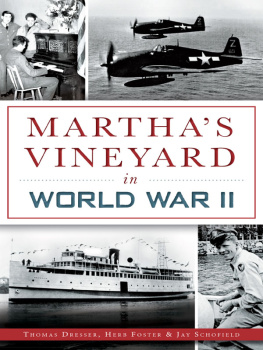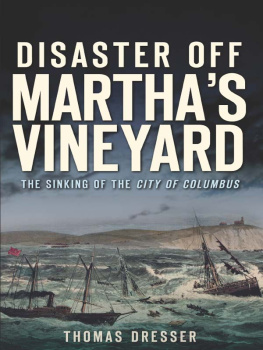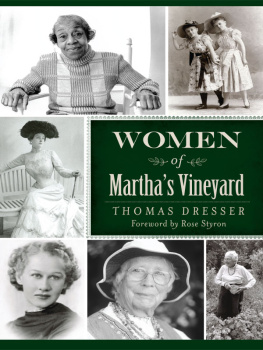

Published by The History Press
Charleston, SC 29403
www.historypress.net
Copyright 2014 by Thomas Dresser, Herb Foster and Jay Schofield
All rights reserved
First published 2014
e-book edition 2014
ISBN 978.1.62584.865.9
Library of Congress Cataloging-in-Publication Data
Dresser, Tom.
Marthas Vineyard in World War II / Thomas Dresser, Herb Foster and Jay Schofield.
pages cm
Includes bibliographical references and index.
print edition ISBN 978-1-62619-372-7
1. World War, 1939-1945--Massachusetts--Marthas Vineyard. 2. Marthas Vineyard (Mass.)--History--20th century. I. Foster, Herbert L. II. Schofield, Jay, 1942- III. Title.
D769.85.M41M374 2014
940.5374494--dc23
2014010152
Notice: The information in this book is true and complete to the best of our knowledge. It is offered without guarantee on the part of the author or The History Press. The author and The History Press disclaim all liability in connection with the use of this book.
All rights reserved. No part of this book may be reproduced or transmitted in any form whatsoever without prior written permission from the publisher except in the case of brief quotations embodied in critical articles and reviews.
This book is dedicated to the servicemen and women and citizens of Marthas Vineyard who gave so much during World War II.
CONTENTS
FOREWORD
During World War II, the entire Vineyard community mobilized to support the war effort, both on the homefront and overseas. Vineyard men and women served abroad in every theater of the war. The Vineyards location made it a strategic outpost for both military training and coastal communications and surveillance.
In the early 1940s, the island became a bustling center of military activity. One square mile of land at the heart of the state forest was taken by the federal government to construct the Marthas Vineyard Naval Auxiliary Air Facility (now the Marthas Vineyard Airport) for training new pilots and for R&R and refresher courses for seasoned airmen. The military maintained installations at the Vineyards high ground on Peaked Hill in Chilmark and at a gunnery training facility in Katama. Ground and air training maneuvers were carried out along the islands north and south shore beaches, with landing forces often making incursions into the islands interior and wooded areas. New roads were built. The United States Coast Guard was on high alert in Gay Head, Chappaquiddick and every corner of the island. Civilian Defense and United Service Organizations (USOs) were active in island towns. The lives of Vineyarders of all ages were affected by the wartime activity, and islanders responded with shared sacrifice and embraced civil defense responsibilities through a range of civilian support activities.
In my work conducting oral history interviews on Marthas Vineyard for more than twenty-five years, the stories and recollections of World War II are among the most poignant and powerful. The personal stories and perspectives of Vineyard people who lived through the war years bring alive in a powerful way the tenor and emotions of that difficult time.
Hearing stories in the words of neighbors you know can bring a distant time and experience to life. We can feel and relate much more closely to the stories from those who served overseas of their longing for their island home and family and the horror and confusion of battle. Hearing the words of those who stayed on the island, we get a sense of how acutely Vineyarders of all ages were affected by the war. In the stories from servicemen assigned to this island outpost (for many of them, a place of which they had never heard), we see how the Vineyard and its people had a profound, often lifelong impact on these young soldiers and airmen, fostering bonds of friendship and marriage.
Events from those times that register in memory are deeply personal and subjective: thoughts of peace while sitting in a shack heated by a potbelly stove by the East Chop Lighthouse watching for enemy planes; nervousness while patrolling the pitch-dark streets of Vineyard Haven, checking for lights-out; applying makeup to ones legs to mimic nylon stockings; adding vials of orange food coloring to make unpleasant-tasting rationed margarine resemble butter; wrapping gum wrappers and tin foil into balls for the war effort; the excitement and fear of rumors of submarines off Gay Head and Squibnocket.
These are the details and feelings that make the past uniquely accessible to us. And these stories will open your eyes and help you see the island in a different way. The wooden building you pass on Beach Road housed a workshop where talented island craftsmen built ship and airplane silhouettes and models for combat training. The Cronigs Real Estate building on Main Street in Vineyard Haven was the hub for USO activity on the island, welcoming servicemen from Peaked Hill and the Naval Air facilities. Through these stories, we become so aware that the past is always around us.
It is vital to collect and preserve these personal recollections to further our understanding of a past that we can use to help shape a better future. Also, we must never forget the tragedies and triumphs, the momentous moments and small happenings that have made us who we are. These stories and photos assembled and skillfully interwoven here by Tom Dresser, Jay Schofield and Herb Foster bring alive to us a pivotal time in the history of the people of the Vineyard. Looking through these Vineyard-colored lenses helps us understand a vital time in world history.
The personal and emotional dimension provided by oral histories transports the reader and enlivens the past in a unique way. While we share in the joys and sorrows of these individuals, we are also reminded of the tremendous importance of their sacrifice during this critical period in the history of the twentieth century.
The vitality of these recollections and the preservation of the photographs, diaries and letters through the years, in closets, basements and photo albums, indicates the impact the war had on the lives of the men and women of the Vineyard community.
Linsey Lee
Curator of Oral History
Marthas Vineyard Museum
For more than twenty-five years, Linsey Lee has collected oral histories on Marthas Vineyard. She is the author of Vineyard Voices: Words, Faces and Voices of Island People, 1998; More Vineyard Voices, 2006; Those Who Serve: Marthas Vineyard and World War II, 2011; and Edible Wild Plants of Marthas Vineyard, 1976.

To listen to audio tapes edited from World War II oral histories, visit the Marthas Vineyard Museum:www.mvmuseum.org/wwii.php.
PREFACE
THE INVASION OF MARTHAS VINEYARD
Wednesday, August 19, 1942. The war is on. Awakened at 5 am by the roaring of motor boats and planes and shots in the direction of Seven Gates, sounding like the 4th of July. Out of bed before six and after attending to the oil difficulties, and orange juice and coffee, put on my hip rubber boots and went up on the hill. Nothing to be seen but hundreds of boats in the Sound and planes overhead.
Seventy-four-year-old retired newspaper editor George A. Hough (18681955) was jolted awake at that early morning hour by armed forces invading the bucolic island of Marthas Vineyard. Hough was a responsible reporter; he maintained journals of his Vineyard experiences from 1899 until his death. He lived at Fish Hook on Indian Hill, in West Tisbury, and also owned the nearby Ephriam Allen house. Retired as editor of the
Next page













